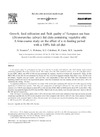Identificador persistente para citar o vincular este elemento:
https://accedacris.ulpgc.es/jspui/handle/10553/1005
| Título: | Growth, feed utilization and flesh quality of European sea bass (Dicentrarchus labrax) fed diets containing vegetable oils : a time-course study on the effect of a re-feeding period with a 100% fish oil diet | Autores/as: | Montero, D. Robaina, L. Caballero, M. J. Ginés, R. Izquierdo, M. S. |
Clasificación UNESCO: | Investigación | Palabras clave: | Aceites esenciales Lubina (Peces) Alimentación Crecimiento Vegetable oil, et al. |
Fecha de publicación: | 2005 | Publicación seriada: | Aquaculture | Resumen: | In the present study 75 g European sea bass were fed for 8 months with different diets (22% dietary lipid content) containing vegetable oils at two inclusion levels. The control diet (Diet FO) contained anchovy oil as the only lipid source; in diets 60RO, 60LO, and 60SO of fish oil was substituted by rapeseed, linseed or soybean oils, respectively; finally, in diet 80LO, 80% of the fish oil was substituted by linseed oil. Fish were fed to apparent satiation three times a day. All fish were individually weighed once per month. Lipid and fatty acid composition of diets and fish fillets were determined at the beginning, middle and end of the experimental period. Once the commercial size was reached, all fish were fed a 100% FO containing diet during 150 days. No significant differences were found in feed intake. Fish fed the diets containing 80% linseed oil or 60% rapeseed oil had significant (P < 0.05) lower growth. Flesh fatty acid composition of total lipids reflected the fatty acids in the diets. Flesh contents of n-3 HUFA were reduced to about 45% in fish fed diets 60RO, 60LO or 60SO and to about 50% in diet 80LO. This reduction was markedly higher for EPA than for DHA. High levels of oleic, linoleic and linolenic acids were found in fish fed RO, SO and LO respectively. After 150 days of re-feeding period with a 100% fish oil diet, DHA levels were restored in those fish previously fed diets containing vegetable oils, but EPA levels remained lower when compared with fish fed 100% FO diet. Flesh content of linoleic and linolenic acids remained higher in those fish previously fed soybean and linseed oil containing diets, respectively. | URI: | https://accedacris.ulpgc.es/handle/10553/1005 | ISSN: | 0044-8486 | DOI: | 10.1016/j.aquaculture.2005.03.003 | Fuente: | Aquaculture [ISSN 0044-8486], v. 248 (1-4), p. 121-134 |
| Colección: | Artículos |
Citas SCOPUSTM
230
actualizado el 08-jun-2025
Citas de WEB OF SCIENCETM
Citations
214
actualizado el 08-jun-2025
Visitas
343
actualizado el 09-ene-2026
Descargas
585
actualizado el 09-ene-2026
Google ScholarTM
Verifica
Altmetric
Comparte
Exporta metadatos
Los elementos en ULPGC accedaCRIS están protegidos por derechos de autor con todos los derechos reservados, a menos que se indique lo contrario.
